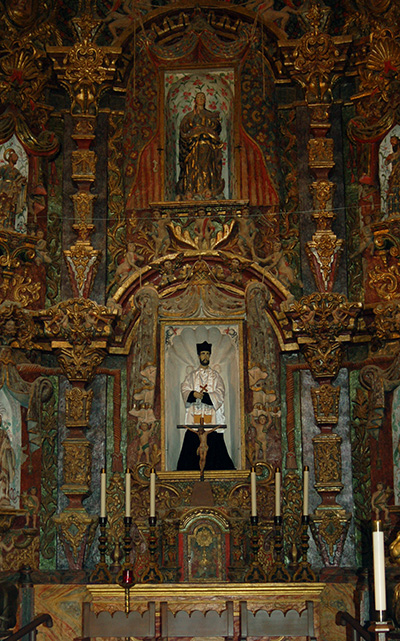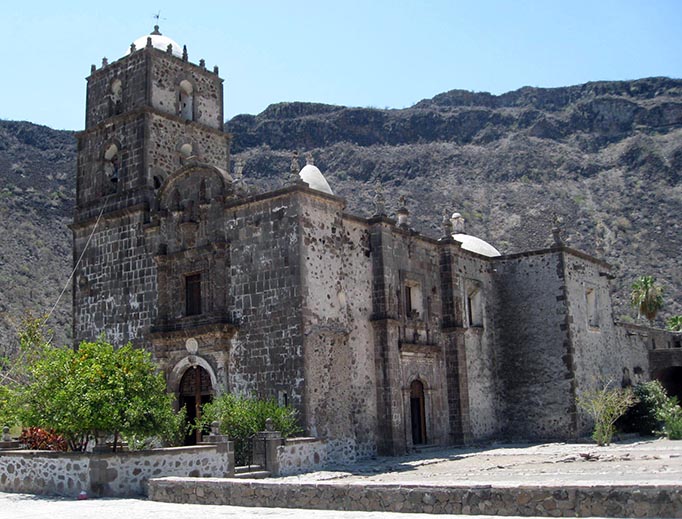6 Beautiful Churches in States Surrounding California
6 noteworthy churches in Arizona, Nevada, Oregon, and Baja California.

Here's one more installment in my beautiful churches series, this one featuring some impressive churches in states that border California:
Chapel of Mary, The Grotto, Portland, Oregon
The Grotto is actually much more than a single church, it is a 62-acre shrine operated by the Servite order in East Portland. It was established by Servite Father Ambrose Mayer in 1923; he built it in thanksgiving to the Blessed Mother for her role in sparing the life of his mother years before when she nearly died after childbirth. He began by carving out a grotto and building a stone altar where outdoor Masses could be celebrated. In 1955, the shrine’s church, the Chapel of Mary, was dedicated by the Portland Archbishop. The Grotto was designated a National Sanctuary in 1983.
It has two levels. The entry/lower level has a gift shop (which, along with donations, funds the facility), the outdoor grotto plaza where Mass can be celebrated and the Chapel of Mary. The chapel has many beautiful works of art, including works depicting the seven holy founders of the Servite Order. For $6 general admission, you can take an elevator to the upper level, which has beautiful gardens, streams and ponds, hundreds of statues, the Servite residence, and, of course, the tall fir trees for which the Pacific Northwest is famous. There’s also a great view of the city from the upper level.
It’s a wonderful place to bring a rosary and prayer book, and spend the day walking around, enjoying the beauty of the grounds and (mostly) traditional Catholic art. There are many unique and special pieces; for example, on the upper level, look for the bronze statue of Our Sorrowful Mother blessed in the Vatican by Pope Pius XI in 1934. You can walk the Stations of the Cross, or see images of the Mysteries of the Rosary. As the Servites are devoted to the Blessed Mother, you can see many Marian works of art. You also may see a Servite friar or two walking the grounds.
There are many special seasonal activities; they are known, for example, for their magnificent Christmas Festival of Lights. There are also many special devotions as well as regularly scheduled Masses; check their website. Most Masses are celebrated in the Chapel of Mary, although some are in the outdoor grotto, weather permitting.
St. Mary’s in the Mountains Church, Virginia City, Nevada
St. Mary’s in the Mountains is a historic parish of the Diocese of Reno, Nevada, and is a short drive from Lake Tahoe. It was founded in 1862 to serve a once-bustling silver mining community in the area (on top of the Comstock Lode, a rich deposit of silver ore in the eastern slope of Mount Davidson), but as the silver deposits petered out in the 20th century it has become a tourist town with St. Mary’s a prominent feature. The fictitious Ponderosa Ranch of the 60s television show Bonanza was located near Virginia City; among its most famous residents was writer Samuel Clemens/Mark Twain, who worked as a reporter for the local newspaper.
The original church burned down in a fire, and the current church was rebuilt in 1876. It is built in the gothic style. The interior has magnificent art and woodwork, with historic items such as an 1870 baptismal font and old vestments. The church has a beautiful traditional altar and stained glass windows, furnishings imported from France and pews made from California redwoods. Virginia City has fewer than 1,000 residents today. During the winter, about a third of those attending Mass are tourists, and in the summer about half.
Mission San Xavier del Bac, Tucson, Arizona

There is a museum and gift shop on the grounds, and a room where you can watch a movie about the history of the mission. There is a Patronato San Xavier group which promotes restoration, maintenance and preservation of the Mission. Tour the mission yourself or check for details about taking a docent tour.
Also, alongside the church there is a hill with a white cross atop it. In the side of the hill is a Lourdes grotto replica, built by the Bishop of Tucson in 1908. It has a magnificent view of Tucson in the distance, as well as the surrounding mountains. Also on the grounds is a Shrine to St. Francis of Assisi, to which many bring their petitions.
St. Francis de Sales Cathedral, Baker City, Oregon
St. Francis de Sales is the cathedral parish of the Diocese of Baker, the eastern two-thirds of the State of Oregon. The cathedral is in the northeast corner of the state, not far from the Idaho border. It’s a beautiful, historic Gothic revival church, built 1906-08, made of volcanic tuff stone on the exterior with colorful stained glass windows and traditional statues and paintings inside.
Baker City was once home of the chancery office of the diocese, but it was moved to the more central and populated Bend in 1985. The bishop may celebrate Christmas and Easter at the cathedral, and there is an annual Chrism Mass. Other significant events, such as the ordination of priests, are held in Bend, about a 5-hour drive away.
St. Margaret Mary Church, Bullhead City, Arizona
St. Margaret Mary Church is in the Diocese of Phoenix. The parish was established in 1947; the current church was built in 2011. Unlike many new chuches, it is surprisingly traditional, its design by Notre Dame professor Duncan Stroik. It is built in the mission style to match the Mojave Desert in which it is located. It has many beautiful features, such as a 27-foot baldacchino (canopy over the altar) with a crucifix suspended from it.
San Javier Mission, near Loreto, Baja California, Mexico
Mission San Javier was established by Jesuit priests in 1699. It is located in a valley in the Sierra de La Giganta (a mountain range), 22 miles from Loreto. Features include the historic mission itself, and the small, quaint town it serves. To get there, you’ll take a long, winding road through the desert and up into the mountains. Stop along the way and enjoy cave paintings, which are said to date back thousands of years.
Construction of San Javier Mission began in 1744, and was completed in 1759. The church is built of stone, brought in from the surrounding areas. The walls are as much as seven feet thick, keeping the interior of the church cool during the region’s hot summers. The insides are decorated with Spanish and Italian art, including oil paintings and statues, which are older than the building itself. The church also has glass windows, not often found in early mission churches. It is named for St. Francis Xavier, an early Jesuit known for his missionary work in India. The church is an architectural gem, one of the best preserved in the region, and is a favorite destination of Loreto tourists.
Other special features of the town include its aqueduct, which you’ll see as you enter. It was built centuries ago to sustain the small community.
Today, San Javier includes residents who have lived there for many generations. They provide for their needs by farming and raising livestock, as well as providing cordial hospitality for the tourists who visit.














